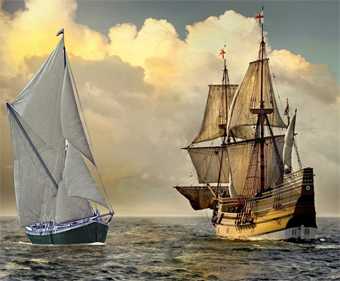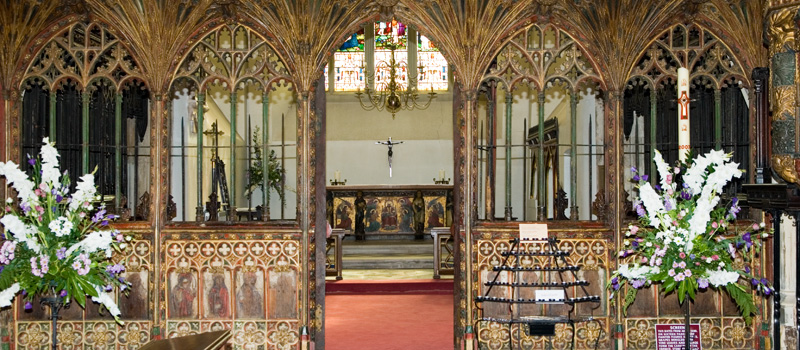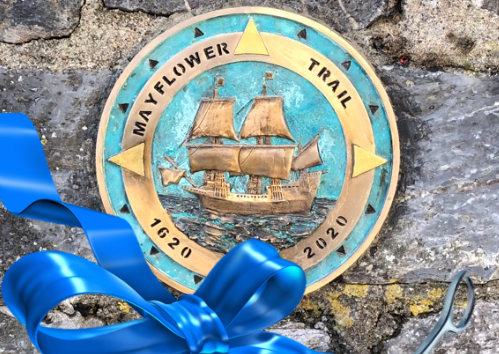

- Contact Us
- Search
-
Mayflower400 partner destinations:
10 things you didn't know about Dartmouth
May 13, 2020
Dartmouth is a truly picturesque town, combining heritage, fantastic shopping and places to eat, with a vibrant waterfront that hosts an active sailing community.
Indeed, its annual Royal Regatta is one of the largest sailing events in the UK, and attracts visitors from all over the world.
The town is situated on the bank of the River Dart in South Devon and has very strong connections to the Mayflower story.
Here are 10 things you may or may not know about Dartmouth...
1) Dartmouth’s skilled craftsmen saved the Pilgrims

Having set sail from Southampton, the Mayflower (carrying Pilgrims from the north of England), and the Speedwell (carrying the Separatists from Leiden in Holland) didn't get very far before the latter began to take on water again, so both ships diverted to Dartmouth for repairs, arriving on 23 August 1620.
According to passengers, the Speedwell was leaking like a sieve and required urgent attention. The Pilgrims were regarded with some suspicion by the Dartmouth locals and while the repairs were made in Bayard’s Cove harbour, the Mayflower moored upstream on the River Dart beside what is now known as Pilgrim Hill.
It took about a week for the port's skilled craftsmen to make good the damage before the ships headed out into the English Channel, bound for the North Atlantic.
So, if it weren't for the skilled craftsmen of Dartmouth nearly 400 years ago, the Pilgrims’ story may have had a very different ending.
2) Dartmouth has a rich naval history

Visit Britannia Royal Naval College and join expert resident tour guides on a voyage from past glories to the present day.
During the tour you will be taken into the heart of the College, from the Chapel, through to the Quarterdeck, Parade Ground, Senior Gun Room and Britannia Heritage Museum.
Since 1863, Dartmouth has been the home of initial Naval Officer training in the UK. Today, it is the only remaining Naval College in the country. Discover many features and facets of life at the College, from the earliest days through the Second World War, right up to the world-class training being delivered today.
Public tours start from a convenient pick-up point in Dartmouth town. In a manageable group size, you will be taken to the College by coach for a walking tour, which lasts approximately two-and-a-quarter hours.
3) Dartmouth has its own castle

For more than 600 years, Dartmouth Castle has guarded the narrow entrance to the Dart Estuary and the busy, vibrant port of Dartmouth.
One of the most beautifully located fortresses in England, it enjoys stunning views of the estuary and out to sea and offers a great family day out, whatever the weather.
Built in 1388, Dartmouth Castle was the first UK castle to mount ship sinking cannon.
Part of English Heritage, there is a cafe on site, and visitors can enjoy beautiful walks around the castle itself.
4) … and an historic military fort

Bayards Cove Fort was built between 1522 and 1536, and contained heavy guns to protect Dartmouth harbour town from attack.
The Pilgrim Fathers would almost certainly have caught a glimpse of the Tudor fort as the Mayflower and Speedwell departed the Devon town some four centuries ago.
The fort was the last line of defence against enemy ships that had eluded Dartmouth and Kingswear castles, and the iron chain stretched across the Dart estuary between them.
Occupying a terrace cut from the rocky riverbank, Bayard’s Cove Fort is picturesquely sited at the entrance to Dartmouth harbour.
5) Dartmouth features one of the county’s most historic churches

Dating back to 1372, St Saviour’s Church is almost hidden by the Victorian development of the Quay, though you can catch a glimpse when you look across the River Dart from Kingswear.
Permission for a church to be built on the site was given by Edward I in 1286 when he came to inspect the harbour for his use in his French campaigns. The Bishop of Exeter and the Abbot of Torre, who appointed the priests of St Clement's and had not been consulted, objected and their objections were great and lengthy.
Eventually, in October 1372 Bishop Brantingham of Exeter consecrated the Church in honour of the Holy Trinity but in 1430 was known as St. Saviour's.
Of particular interest is the large memorial brass to John Hawley, believed to be Chaucer's 'Shipman' in the Canterbury Tales as well as the major donor of funds to construct the building and an (in)famous local politician.
6) There are SIX other ‘Dartmouths’ in the world

Including the Devon town, there are seven places in the world named ‘Dartmouth’.
The name appears twice in Australia – in Victoria and Queensland – while there is also a ‘Dartmouth’ in the following locations: North America (Kansas), Guyana, Guatemala, and Canada.
The distance from Dartmouth, UK, to Dartmouth, US, is around 4,440 miles as the crow flies.
7) Dartmouth has a hotel that dates back four centuries

The Royal Castle Hotel is a 16th Century traditional English coaching inn which is situated on the quayside.
It has many historical links with the developments of the port of Dartmouth and the Britannia Royal Naval College.
Past royal visitors have included Prince Charles and Prince Andrew, famous sailors Sir Francis Chichester and Chay Blyth, and film stars Cary Grant and Donald Sutherland.
The hotel is privately owned and has 24 award-winning, individual en-suite bedrooms, offering optional spa baths, four-poster beds, air-conditioning and river views. Many rooms are home to a charming collection of fine antiques and interesting features.
8) Dartmouth is building a replica model of the Mayflower
In spite of current conditions, most of the Dartmouth Mayflower 400, 2020 projects continue. Lockdown has brought new challenges for the team building the Replica Mayflower model, destined for the Mayflower Exhibition in the Museum.
The Sandquay, BRNC, workshop is currently closed with the almost complete hull of the model safely still on site. Meanwhile the team of volunteers have taken to working safely in their own homes by changing around their project plan.
Captain Ian Kirkwood's revised plan, moving the planned June work to April, has enabled the ever-resourceful team to continue progress on the model from the inside out.
Fully complying with isolation restrictions and now working in their own homes on masts, spars, rigging, ladders and doors, barrels and capstan, research and internal contents are: Ian and Niki Kirkwood, Spencer Wigley, Aiden James, Phil Braakenburg, David Heron, and Bob Hart. Along with John Lancaster, the Master Woodturner is helping from Barnstaple.
Home workshops have been modified, tools and equipment moved, and innovative new machines built. Dartmouth now has its first rope-making facility in hundreds of years. The team are working to reduce the impact of the current lockdown on their timetable. Good progress is being made, morale is high and they are all learning new skills.
9) You can follow in the Pilgrims’ footsteps

The Dartmouth Heritage Trail offers visitors the opportunity to discover more about the Devon town’s links to the historic voyage across the Atlantic in 1620.
The trail consists of three sections: a town trail, a walking trail and a castle trail.
All three trail elements link up, and also link with a River Trail, taking in the historic seafaring locations and the Pilgrims’ encampment further upriver.
Although the trail focuses mainly on the story of the Separatists, the Mayflower and the Speedwell, you’ll also learn all about the interesting events in Dartmouth since the 12th century - taking in 13 historic locations.
10) … and learn more about them

Dartmouth hosted a number of fantastic events and activities during the Mayflower 400 commemoration year.
Find out more about Dartmouth’s Mayflower programme here.
Sign up for the latest Mayflower 400 news
You'll be the first to hear the latest Mayflower news, events, and more.
Log In
Register
Mayflower 400 Proudly Supported by our National Sponsors and Funding Partners






